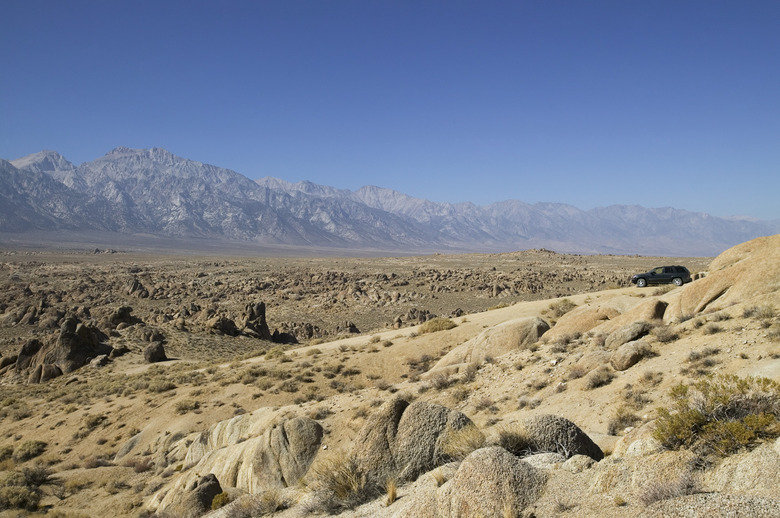Types Of Desert Fungi
Deserts contain a variety of fungi. Some colonies of desert fungi types can live for millions of years by prolonging the development process. Others create symbiotic relationships with other organisms to ensure survival. Desert fungi can lie dormant in desert soil until disturbed, then attack with toxic spores that cause serious illness. Some types of desert fungi can paint desert canvases with dapples of bright colors.
Lichens
Lichens
Lichens, known as "pioneer plants," are tiny organisms that can endure rough, hot and cold environments and droughts. A lichen's body, or thallus, is composed of algae and fungus that grow together in a symbiotic relationship. The algae cells provide nutrients for the fungus, and the fungus shields the algae from atmospheric conditions.
Lichens can grow on unusual surfaces such as sand, rocks, soil, animal bones and rusty metal. Lichens grow in an array of colors such as shades of red, orange, yellow, green and brown. More than a dozen species of fungus can grow on one boulder.
Approximately 15,000 lichen species are known. Certain lichens such as crustose lichens (a crustlike fungus) can live for hundreds or thousands of years because of a slow growth rate. Crustose lichens can develop on rocks. Certain lichens are endangered because contaminated air and rainwater can destroy algae cells, killing the fungal partner.
Mycorrhizae
Mycorrhizae
Mycorrhizae are fungal plant systems that develop a symbiotic relationship with plant roots. The roots provide necessary nutrients and a site for the fungi to attach their threads. The fungi protect the plant from assaults such as pathogens, and their threads work as a root system to help the plant receive additional water and nutrients. Once the relationship is developed, a plant can depend on Mycorrhizae when its nutrients are discontinued.
Mycorrhizae are divided into two types — ectomycorrhizae and endomycorrhizae. Ectomycorrhizae produces a covering around a plant's roots. The covering grows hyphae (threadlike constituents of the body of the fungus) into the roots, then into the soil. Endomycorrhizae threads grow into the cells and then into the soil. The fungus improves drought resistance, disease immunity and nutrient uptake for the host plant.
Mushrooms
Mushrooms
Podaxis, or desert shaggy mane, is found the Sonoran Desert and other deserts around the world. Podaxis is related to the fungi family Agaricaceae. The fungus resembles a puffball; it is woody and fibrous. The fruiting body of the Podaxis springs from desert soils, sandy soils and roadsides after rain seasons. However, if rain does not come, the fruiting body will not emerge. The pileus (cap) stays closed during the development process to protect the fertile tissue, gills and double-walled spores from drying up.
Coccidioides
Coccidioides
The genus Coccidioides is a soil fungus comprising two species — Coccidioides immitis and Coccidioides posadasii. Both species are found in the desert soils of North and South America. Each species creates hyphae and spores in the soil. When the soil containing the spores becomes disturbed by humans or natural assaults such as dust storms, the spores become airborne. Inhalation of spores can cause a non-contagious fungal infection called Coccidiodomycosis, or valley fever. In rare cases, if myriad spores from either species are inhaled, it can be fatal.
References
- Desert USA: "The Desert's Lichen Crust"; Wayne P. Armstrong;1996-2011
- University of Nevada Cooperative Extension; Publications; Horticulture: "Mycorrhizae"; Angela M. O'Callaghan
- Arizona Naturalists: Sonoran Desert Naturalist; Field Guide; Fungi; Desert Shaggy Mane
- Mykoweb.com: California Fungi; Species Index; Podaxis pistillaris
Cite This Article
MLA
McClease, Jenny. "Types Of Desert Fungi" sciencing.com, https://www.sciencing.com/types-of-desert-fungi-12574821/. 21 July 2017.
APA
McClease, Jenny. (2017, July 21). Types Of Desert Fungi. sciencing.com. Retrieved from https://www.sciencing.com/types-of-desert-fungi-12574821/
Chicago
McClease, Jenny. Types Of Desert Fungi last modified August 30, 2022. https://www.sciencing.com/types-of-desert-fungi-12574821/
